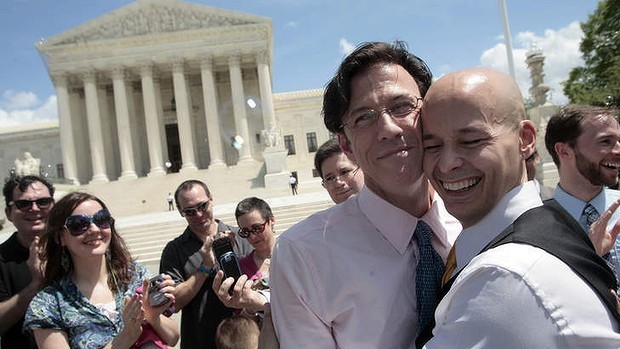A NSW parliamentary inquiry’s conclusion that there is no constitutional impediment to states enacting laws for same-sex marriages represents a breakthrough in the marriage equality debate.
At a stroke it has removed the major rationale state politicians have used for opposing such laws.
“All developments in relationship law in Australia have begun at a state level and then “migrated” to the federal sphere.”
The unconstitutionality of a state same-sex marriage law was the ostensible reason such a law was narrowly voted down in Tasmanian Upper House last year.

It was the reason given last week by the South Australian Liberals for not allowing a conscience vote and effectively dooming a same-sex marriage bill.
It is the reason it has been difficult to gather majority support for reform in the NSW Parliament, despite a cross-party conscience vote.
With that barrier now gone, expect these three states to move ahead quickly, and for others to follow.
I hope to see same-sex couples marrying under the law of at least one state or territory by the end of the year.
But the question of whether states can legislate for same-sex marriage is not the same as whether they should, especially when reform at a federal level is also a possible path forward.
The NSW report itself made this distinction.
While the inquiry “reached the conclusion that the New South Wales Parliament has the power to legislate on the topic of marriage, including same-sex marriage”, it added this caveat:
“If New South Wales chooses to exercise that power and enact a law for same-sex marriage, the law could be subject to challenge in the High Court of Australia. The outcome of such a case is uncertain and therefore equal marriage rights for all Australians may best be achieved under Commonwealth legislation.”
Critics of marriage equality like Professor Patrick Parkinson have taken up this point declaring it would be “a cruel burden” for same-sex couples to marry under a state statute that could be overturned.
But the threat of a High Court challenge is a weak argument for not proceeding with state same-sex marriage laws.
There is no certainty there will be a challenge, especially because it’s not clear who would have standing to take such a case. The churches certainly wouldn’t, given they are not obviously disadvantaged by same-sex marriage.
If a challenge was accepted by the Court there’s no certainty it would succeed. The defence case is a compelling one that has the backing of constitutional heavyweights like Professor George Williams.
On top of this, any federal amendment allowing same-sex marriages could also be subject to a High Court challenge. Does that mean we shouldn’t go ahead? Of course not.
In the end, it’s not the role of legislators to second-guess the courts. It’s their role to do what’s best for their constituents.
So assuming, as a majority of Australians do, that marriage equality is a good thing, are state same-sex marriage laws the best way to move forward on the issue?
Some critics of state same-sex marriage laws say such laws are not what’s best for same-sex couples because marrying under a state statute would be “a second-best marriage”, and because state laws would not be recognised in federal law and would create a patchwork of recogition between states.
“Second-best” is nonsense.
Heterosexual couples did not feel their marriages were second-best when they were solemnised under state law, as they were in Australia until 1961, or that they are second-best because marriage law only deals with heterosexual relationships.
So too, most same-sex couples do not care who has enacted the statute they marry under, and the scope of that statute, as long as they can marry.
At the heart of the marriage equality movement is the aspiration of same-sex couples to have the option of entering into lifelong, exclusive legal marriages.
State laws do this just as well as a national law.
The objection based on lack of recognition between jurisdictions is also hard to swallow.
The same objection could have been made against same-sex de facto relationships, which were recognised at different times and in different ways in different states and territories between 1994 and 2007 and weren’t recognised federally until 2008.
But no-one argued that the first states to move on this important reform should have held off until all the other states and the Commonwealth had caught up.
That’s because we know from experience that where one state leads on a reform whose time has come, others are sure to follow.
In response to their critics, defenders of state same-sex marriage laws often argue that state laws will break the deadlock on marriage equality at a federal level, created by the failure of Tony Abbott to allow Coalition members a conscience vote, and act as a kind of lever for national reform.
At the very least, Australians who remain conflicted about reform will be able to see that the sky doesn’t fall in just because same-sex couples are marrying on Australian soil.
This is a compelling argument in a nation that is being left behind by its closest allies – New Zealand, the UK, the US and Canada.
It would be far preferable for state laws to break the federal deadlock than for the nation to go down the path of a national civil union scheme, or God forbid, an expensive and polarising referendum.
But I’m uncomfortable with an argument that suggests marriages under state law are a means to an end rather than an end in themselves.
More compelling for me is the argument that laws allowing same-sex marriage follow the logic of federalism.
All developments in relationship law in Australia have begun at a state level and then “migrated” to the federal sphere.
As I’ve already noted, heterosexual marriages were solemnised under state laws until the federal Marriage Act was adopted in 1961.
Heterosexual and homosexual de facto laws were legally acknowledged by the states first before their recognition federally.
Same and opposite-sex civil unions also began at a state level before being recognised by the Commonwealth.
The same federal logic can be seen at work overseas.
In every federal nation that has moved forward on marriage equality – Canada, the US, Mexico, Argentina and Brazil – same-sex marriages were recognised first at a state or provincial level.
Seen in this light, it would be anomalous if Australia didn’t recognise same-sex marriages at a state level before it did so nationally.
The desire for a quick and comprehensive national resolution to the marriage equality debate is understandable.
It taps into a long history of Australian reformers discounting the states as sites of innovation and progress, and pinning their hopes on the national government instead.
But to ignore the state path to marriage equality, and focus entirely on a federal parliament that seems paralysed on the issue, may well prolong the debate.
Marriage equality supporters should do whatever we can to increase the chances of reform at a national level, but we should also encourage the logic of federalism to take its course.
We may just find that the path to our destination lies where few people until recently suspected, through the states.
Photo: Domino Postiglione & New York Times
Author: Rodney Croome
Publication: The Age
Date: 30 July 2013

